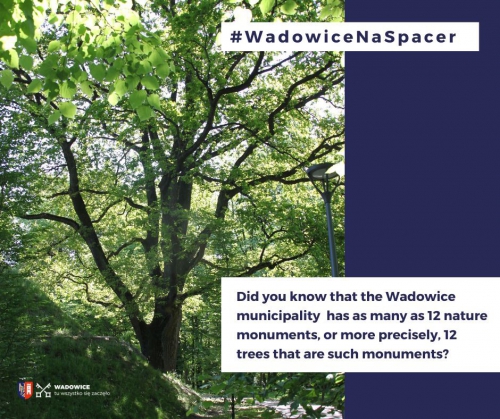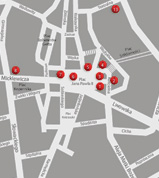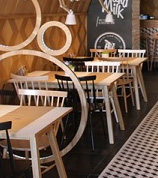
#WadowiceNaSpacer or Walk in the footsteps of nature monuments in the Wadowice municipality
Starting today, we invite you to follow on our FB fanpage (Wadowice - tu wszystko się zaczęło) and on our website our new series #WadowiceNaSpacer, in which we will encourage thematic excursions in Wadowice and the surrounding area! For starters, we would like to take you on a walk in the footsteps of natural monuments in the Wadowice municipality.
Did you know that the Wadowice municipality has as many as 12 nature monuments, or more precisely, 12 trees that are such monuments? Some can be found not far from the town center! How to recognize them? They are marked with special green plaques, on which you can find the emblem of Poland and the inscription: "Monument of Nature Protected by Law".
But what are nature monuments? On the website of the General Directorate of Environmental Protection we find the answer to this: These are individual objects of animate and inanimate nature or their groups which have particular environmental, scientific, cultural, historical or landscape values and present unusual individual features among other objects, e.g. high trees, domestic or foreign species of shrubs, source, waterfalls, rising springs, rocks, ravines, erratic blocks or caves. In the built-up areas, if it does not pose any threat to human and possessions, tress which nature monuments are protected until they naturally break.
In the undeveloped areas, if it does not pose any threat to people or property, tress that are monuments of nature are protected until their spontaneous, complete decay. Nature monuments are established by resolution of the town council.
How to check if we can find such natural monuments nearby? It is worth using the Centralny Rejestr Form Ochrony Przyrody (Central Register of Nature Conservation Forms available) online.
A walk along the trail of natural monuments is a great way to spend a summer afternoon and get acquainted with the richness of the surrounding nature. A google map prepared by us will help you: https://www.google.com/maps/d/edit?mid=1mUs7QU0wPprP2adcIlBeJE7sAh0sKIo&usp=sharing
Natural monuments in the Wadowice municipality:
- Pedunculate Oak - Quercus robur, Town Park at Wolności Avenue in Wadowice, on the slope of Adam Mickiewicz's mound, (entry: 2012). It is a massive tree reaching up to 35-40 m in height. Since it lives for more than 1000 years, it is considered a symbol of strength, longevity and power. Long ago, old oaks were worshipped as deities - believed to have magical powers. Its nuts, called acorns, are valuable food for many mammals and birds.
- Broad-leaved Linden - Tilia platyphyllos L., in the greenbelt of Polna Street, next to the Mikołaj Manor House, (entry: 1993). It is the most common linden tree in villages and near churches. Due to its low resistance to environmental pollution, it is rarely found in cities. The straight trunk of the linden tree reaches up to a height of 40 meters. Linden is a basic tree in beekeeping. It is a long-lived species, living to about 500 years. Its light and soft wood is used for making, among other things, toys and from the bast of young trees mats, ropes, baskets and pawpaws were woven.
- Pedunculate Oak - Quercus robur, in the greenbelt of Polna Street, next to the Mikołaj Manor House in Wadowice, (entry: 2012).
- Small-leaved Linden - Tilia cordata, by the chapel with the image of the Virgin Mary from the 19th century in Jaroszowice, (1998). In ancient Greece, the linden tree was a symbol of purity, innocence and hope. The Slavs revered the tree, considering it sacred. They believed it protected against lightning and evil spirits. The flowers, leaves and bark of the linden tree were used in folk medicine. The tree grows up to 30 meters in height. Small-leaved linden is easily distinguished from broad-leaved linden by the color of the hairs at the angles of the nerves on the underside of the leaf. In small-leaved linden the hairs are brownish, while in broad-leaved linden they are white.
- Small-leaved Linden - Tilia cordata, above the road by the bank of the Skawa River, at the foot of the southern slope of Jaroszowicka Mountain, Jaroszowice (entry: 1998).
- Western Redcedar- Thuja plicata (Thuja gigantea), park by the E. Zegadłowicz Manor House in Gorzeń Górny, (entry: 2004). Native to North America, a fast-growing, long-lived tree, living up to 1,000 years in the wild. It grows up to 30 m in height and maintains a regular, broad conical growth form. A characteristic feature of the species is dark-colored foliage in the form of scales and slightly overhanging young shoots. Western Redcedar as a species is rarely found in Poland, many varieties are very popular.
- Common Elm (Field Elm) - Ulmus minor, park at the E. Zegadłowicz Manor House in Gorzeń Górny, (entry: 1998). This is a tree reaching up to 40 m in height with a dense and spreading crown. Its shoots have a characteristic zigzag shape. To grow into a good-looking tree, the elm needs fertile and moist soils, which is why it feels best in oak-hornbeam and riparian forests. Its wood is used for veneers and flooring. Due to Dutch elm disease, most of the trees in cities have become completely extinct.
- Small-leaved Linden - Tilia cordata, in front of the entrance gate to the Manor House of E. Zegadłowicz in Gorzeń Górny, (entry: 1972).
- Sycamore Maple – Acer pseudoplatanus, private property 117 Zawale Street, Chocznia, (entry: 1998). In Poland, sycamore naturally grows mainly in the mountains and southern lowlands. Together with beech and fir, it is an important component of the forests of the lower regale. In Pomerania it was artificially introduced by man. The leaves turn beautifully yellow or red in autumn. The sycamore provides extremely valuable, almost white wood, used in furniture making and turning. It was maple wood that the famous Trojan horse was built from.
- Penduculate Oak – Quercus robur, next to the church of St. Lawrence the Martyr in Klecza Dolna, (entry: 1964).
- English Yew – Taxus baccata, private plot No. 513, Stanisław Górny, (entry: 1953). This is a tree that grows up to 20 m tall and can live up to 3000 years! Yew is a dioecious tree. It is a species that is difficult to grow. It requires very fertile and moist soils. Yew is sensitive to frost and drought. Its wood is heavy, compact and has very good mechanical and technical properties. That is why it has long been a valued material, which was once used to make, among other things, bows and crossbows. Yew was so intensely felled that it almost disappeared from Polish forests, which is why it was protected as early as 1423.
- Small-leaved Linden - Tilia cordata, next to the Church of St. Alexis in Ponikwi, (entry: 1964).
Descriptions based on www.lasy.gov.pl, www.drzewa.com.pl
Photo: Pedunculate Oak, A. Mickiewicz's mound in the Town Park on Wolności Avenue in Wadowice, Wadowice Town Hall Archive

.png)






